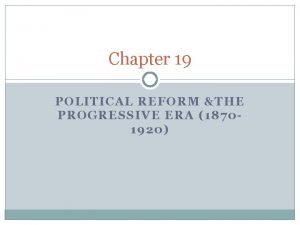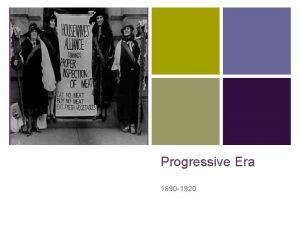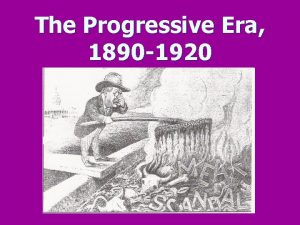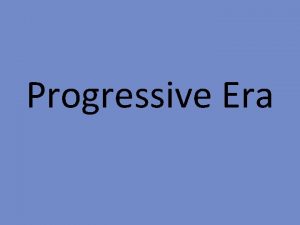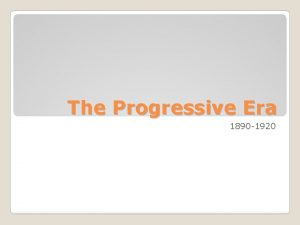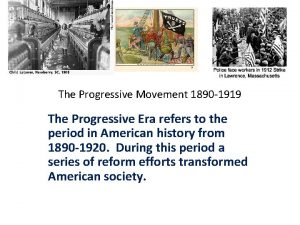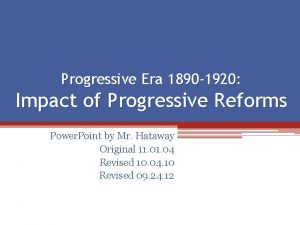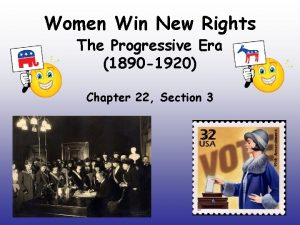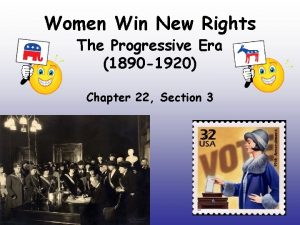PROGRESSIVE ERA AND NEW ERA 1890 S1929 AKE
















- Slides: 16

PROGRESSIVE ERA AND NEW ERA (1890 S-1929) AKE 118 Dr. Gamze Kati Gumus

THE AUTOMOBILE Sociologists Robert and Helen Lynd conducted a major study of American society during the 1920 s in Indiana.

The Automobile The Lynds found that the automobile had such effects as the following: 1. family budgets had changed dramatically 2. ministers complained that people drove their cars rather than going to church 3. parents were concerned that their boys and girls were spending too much time together "motoring” 4. the car had revolutionized the way people spent their free time

CITIES DURING THE PROGRESSIVE ERA For the emerging middle class, benefiting from growing incomes and increases in leisure time, the expanding city offered many advantages. 1. Department stores, chain stores, and shopping centers emerged to meet the growing demand for material goods. 2. Parks, amusement parks, and baseball stadiums were built to meet aesthetic and recreational needs. 3. Transportation systems improved, as did the general infrastructure, better meeting the increased needs of the middle and upper class city dwellers.

IMMIGRANTS IN THE PROGRESSIVE ERA Between 1900 and 1915, more than 15 million immigrants arrived in the United States. That was about equal to the number of immigrants who had arrived in the previous 40 years combined. In 1910, three-fourths of New York City's population were either immigrants or first generation Americans (i. e. the sons and daughters of immigrants).

IMMIGRANTS IN THE PROGRESSIV E ERA Unlike earlier immigrants, the majority of the newcomers after 1900 came from non-English speaking European countries. The principal source of immigrants was now Southern and Eastern Europe, especially Italy, Poland, and Russia, countries quite different in culture and language from the United States, and many immigrants had difficulty adjusting to life here.

IMMIGRANTS IN THE PROGRESSIVE ERA ◦ At the same time, the United States had difficulty absorbing the immigrants. ◦ Most of the immigrants chose to settle in American cities, where jobs were located. As a result, the cities became ever more crowded. In addition, city services often failed to keep up with the flow of newcomers. ◦ Most of the immigrants did find jobs, although they often worked in jobs that most native-born Americans would not take. Over time, however, many immigrants succeeded in improving their condition.

IMMIGRANTS IN THE PROGRESSIVE ERA ◦ The immigrant enclaves in American cities built lively subcultures through their churches, foreign-language newspapers, service organizations, social agencies and immigrant-aid societies, as well as other facilities.

IMMIGRANTS IN THE PROGRESSIVE ERA According to some progressiv es, the immigrants were dangerously illiterate culturally deprived unenlightened Catholics enemies of the free society doomed to a permanently inferior place on the Darwinian scale of races could never master the skills demanded by democracy

DISCRIMINATION AGAINST BLACKS ◦ Many blacks were excluded from the benefits enjoyed by the mainstream Americans based on the so-called scientific evidence of their biological inferiority. ◦ In the South, almost all blacks were excluded from voting. ◦ The lynching of the blacks was a widespread problem in the South whereas race riots acted as a parallel matter in the North.

THE RISE OF SOCIAL FEMINISM Nineteenth-century American women had concentrated for the most part on removing legal barriers to full citizenship—on winning the right to vote and acquiring the right to hold and bequeath property, and stand equal before the law. The new social feminists—represented by the image of young, educated, unmarried women—revolted against the male-imposed definition of female duty as limited by hearth and home. These new women read the challenging writings of Europeans such as Ibsen, Nietzsche, Bergson, and Freud. Feminism was a troubling matter in the eyes of the American public because of the new standards of social and sexual behavior that were not yet legitimized in the moral politics of progressivism.

PROHIBITION (1920 -33)

PROHIBITION ◦ Prohibition exhibited many of the characteristics of most progressive reforms. That is, it was concerned with the moral fabric of society; ◦ it was supported primarily by the middle classes; ◦ it was aimed at controlling the "interests" (liquor distillers) and their connections with venal and corrupt politicians in city, state, and national governments. ◦ In 1918, Congress passed the 18 th Amendment to the Constitution, prohibiting the manufacture, transportation, and sale of alcoholic beverages. States ratified the Amendment the next year. It went into effect in January 1920.

PROHIBITION The effort to regulate people's behavior soon ran into trouble. 1. Enforcement of prohibition became very difficult. 2. Soon, such terms as "bootlegger, " "bath tub gin, " and "speakeasy" became household words. 3. Gangs of hoodlums became more powerful as they trafficked in alcohol. By the 1930 s, a majority of Americans had tired of the noble experiment, and the 18 th Amendment was repealed.


 Ake lääkkeet
Ake lääkkeet Ake security
Ake security Matkin brat
Matkin brat Tipu ake
Tipu ake Pleseň hlavičkatá rozmnožovanie
Pleseň hlavičkatá rozmnožovanie Ako vypocitat mierku
Ako vypocitat mierku Ake druhy mierky map pozname
Ake druhy mierky map pozname A-e words phonics list
A-e words phonics list Anthea
Anthea Ake upgrade
Ake upgrade Fr er
Fr er Function of present perfect continuous tense
Function of present perfect continuous tense What is passive
What is passive Simple past tense and past progressive
Simple past tense and past progressive Chapter 19 political reform and the progressive era
Chapter 19 political reform and the progressive era Africa 1890
Africa 1890 Kirjanik 1898-1978
Kirjanik 1898-1978














